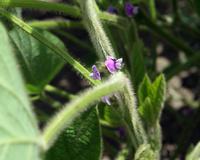
Sója
(glycine max, soy, japonsky daidzu)
Sója je luštěnina z východní Asie, hojně pěstovaná v potravinářství (levné proteiny, olej). Kromě isoflavonů obsahuje také zdraví prospěšné saponiny.
Hlavní bioaktivní složky
- isoflavony: daidzein, genistein<
O jejich účinku viz kapitola isoflavony. - kyselina fytová (inositol-hexafosfát = zásobárna fosforu v rostlinách), kyselina alfa-linolenová (omega-3 základní NMK = nenasycená mastná kyselina) a saponiny (snižují cholesterol, chemoprevence, imunomodulace, antioxidans).
Medicínský souhrn
Sójové isoflavony jsou najčastěji používané a nejprozkoumanější isoflavony na menopauzální obtíže. Existuje řada studií potvrzujících efekt na menopauzální symptomy.
- 2296: Washburn S, Burke GL, Morgan T, et al. Effect of soy protein supplementation on serum lipoproteins, blood pressure, and menopausal symptoms in perimenopausal women. Menopause 1999;6:7-13.
- 2297: Albertazzi P, Pansini F, Bonaccorsi G, et al. The effect of dietary soy supplementation on hot flushes. Obstet Gynecol 1998;91:6-11.
- 3978: Tham DM, Gardner CD, Haskell WL. Clinical review 97: Potential health benefits of dietary phytoestrogens: a review of the clinical, epidemiological, and mechanistic evidence. J Clin Endocrinol Metab 1998;83:2223-35.
- 3986: Brzezinski A, Adlercreutz H, Sheoul R, et al. Short-term effects of phytoestrogen-rich diet on postmenopausal women. Menopause 1997;4:89-94.
- 3987: Kurzer M. Hormonal effects of soy isoflavones: Studies in premenopausal and postmenopausal women. J Nutr 2000;130:660-1.
- 7653: Nagata C, Takatsuka N, Kawakami N, Shimizu H. Soy product intake and hot flashes in Japanese women: results from a community-based prospective study. Am J Epidemiol 2001;153:790-3.
- 9917: Balk JL, Whiteside DA, Naus G, et al. A pilot study of the effects of phytoestrogen supplementation on postmenopausal endometrium. J Soc Gynecol Investig 2002;9:238-42.
- 11805: Huntley AL, Ernst E. Soy for the treatment of perimenopausal symptoms–a systematic review. Maturitas 2004;47:1-9.
- 4751: Scambia G, Mango D, Signorile PG, et al. Clinical effects of a standardized soy extract in postmenopausal women: a pilot study. Menopause 2000;7:105-11.
- 6455: Upmalis DH, Lobo R, Bradley L, et al. Vasomotor symptom relief by soy isoflavone extract tablets in postmenopausal women: A multicenter, double-blind, randomized, placebo-controlled study. Menopause 2000;7:236-42.
- 7802: Han KK, Soares JM Jr, Haidar MA, et al. Benefits of soy isoflavone therapeutic regimen on menopausal symptoms. Obstet Gynecol 2002;99:389-94.
- 9916: Burke GL, Legault C, Anthony M, et al. Soy protein and isoflavone effects on vasomotor symptoms in peri- and postmenopausal women: the Soy Estrogen Alternative Study. Menopause 2003;10:147-53.
- 10460: Albert A, Altabre C, Baro F, et al. Efficacy and safety of a phytoestrogen preparation derived from Glycine max (L.) Merr in climacteric symptomatology: a multicentric, open, prospective and non-randomized trial. Phytomedicine 2002;9:85-92.
- 11805: Huntley AL, Ernst E. Soy for the treatment of perimenopausal symptoms–a systematic review. Maturitas 2004;47:1-9.
- 11993: Nahas EP, Neto JN, DeLuca L, et al. Benefits of soy germ isoflavone in postmenopausal women with contraindication for conventional hormone replacement therapy. Maturitas 2004;48:372-80.
- 11994: Crisafulli A, Marini H, Bitto A, et al. Effects of genistein on hot flushes in early postmenopausal women: a randomized, double-blind EPT- and placebo-controlled study. Menopause 2004;11:400-4.
- 13209: Kaari C, Haidar MA, Junior JMS, et al. Randomized clinical trial comparing conjugated equine estrogens and isoflavones in postmenopausal women: a pilot study. Maturitas 2006;53:49-58.
- 15220: Howes LG, Howes JB, Knight DC. Isoflavone therapy for menopausal flushes: a systematic review and meta-analysis. Maturitas 2006;55:203-11.
- 15850: Nelson HD, Vesco KK, Haney E, et al. Nonhormonal therapies for menopausal hot flashes: systematic review and meta-analysis. JAMA 2006;295:2057-71.
…existují i srovnávací studie (11994) sójových isoflavonů (54mg daidzeinu/d) s konvenčními estrogeny (1mg 17-beta estradiolu/d), kdy daidzein snižoval výskyt návalů o 22-29% oproti 53% u estrogenu a také studie, kdy byly sójové isoflavony (60mg/d) srovnatelné s efektem konjugovaných estrogenů (Premarin 0,625 mg/d): (13209)
Ne všechny studie vycházely pozitivně – nejednoznačné výsledky však vždy byly spojeny s nižší dávkou sójových isoflavonů: pokud byla denní dávka daidzeinu alespoň 15mg, efekty se vždy dostavily.


Leave a Reply
Want to join the discussion?Feel free to contribute!